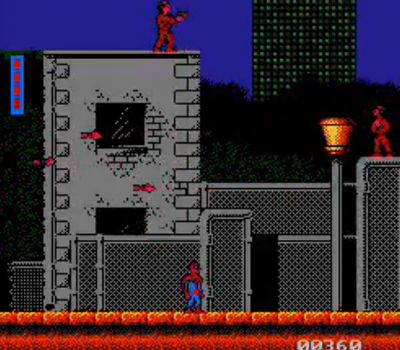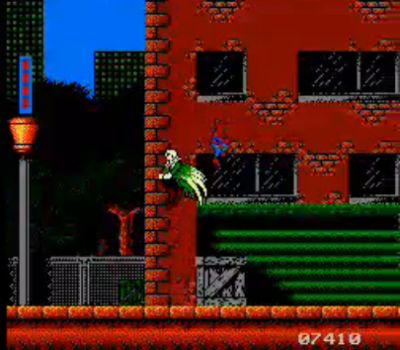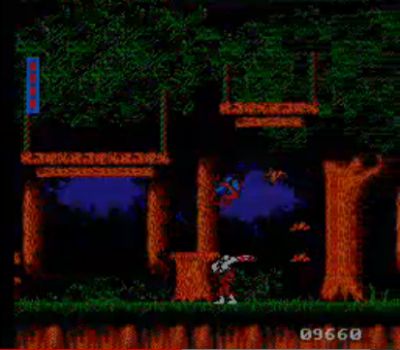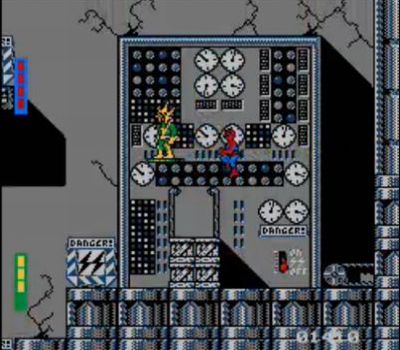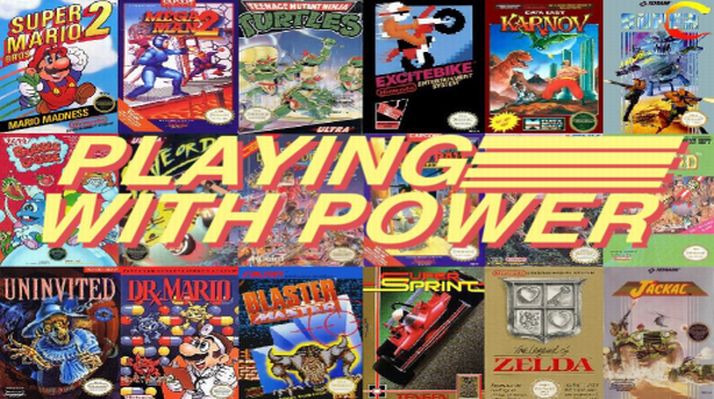 Welcome to another edition of Playing With Power. The review article that looks at all things Nintendo Entertainment System. It’s time once again to deal with the infamous LJN. And given their track record here on Playing With Power, it’s looking like another rough road again. LJN has handled everything from Back to the Future, Bill and Ted, and as we saw last week, A Nightmare on Elm Street. So, how could they go wrong with a game based on your friendly neighbourhood Spider-Man?
Welcome to another edition of Playing With Power. The review article that looks at all things Nintendo Entertainment System. It’s time once again to deal with the infamous LJN. And given their track record here on Playing With Power, it’s looking like another rough road again. LJN has handled everything from Back to the Future, Bill and Ted, and as we saw last week, A Nightmare on Elm Street. So, how could they go wrong with a game based on your friendly neighbourhood Spider-Man?
Yeah, it’s easy to guess that they can go really wrong here. Let’s see if they badly botched the wall crawler with Spider-Man: Return of the Sinister Six.
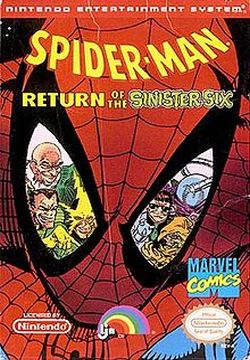 YEAR OF RELEASE: 1992
YEAR OF RELEASE: 1992
PUBLISHER: LJN
GENRE: Action Platformer
It’s safe to say that pretty much everyone here is well aware of Spider-Man, and well aware of his origin. But for those who need a pick me up, here’s a reminder (from someone who isn’t the biggest comic book buff).
Debuting in Amazing Fantasy #15 in 1962, Spider-Man is the story of Peter Parker. Once a normal nerdy kid, who after being bitten by a radioactive spider, gains the proportionate powers of a spider. And after learning the hard way that “With Great Power Comes Great Responsibility” becomes one of the world’s most beloved superheroes.
But surprisingly, despite Spidey’s popularity, he didn’t have too many video games until the 90’s. There was the Atari 2600, and save for the odd computer game, there was nothing of note. Spidey saw a boom of games for all consoles under the sun. But for the great grey box, which was already in its twilight days, there were none until late 1992 when LJN, who still had the rights to several Marvel franchises including X-Men and The Punisher, finally gave Spider-Man his first and only NES title.
Unfortunately for the web head, LJN’s one competent developer company, Rare had flown the coop, so LJN would assign the company known as B.I.T.S to develop. I know nothing about B.I.T.S,, and I have very little clue what other games they worked on. Spider-Man: Return of the Sinister Six was released in October of 1992, with a port for the Sega Game Gear released the following year, and was met with rather scathing reviews. But were they justified? Let’s find out.
COVER STORY
If I can’t fault LJN for one thing, it’s that they certainly knew how to make a video game cover, and this one is definitely among their best. Great artwork here with Spider-Man, and all of his foes from the Sinister Six in his eyes. This cover kinda creeped me out as a kid, dunno why. But at least it’s not as creepy as Return of the Joker. Definitely an eye catcher, but maybe also an example of a great game cover released at the wrong time.
STORY
Doctor Octopus has escaped from prison, and is intent to not only take over New York, but to squash his long time foe Spider-Man as well. And to aid in that, he’s reunited with his former friends of the Sinister Six. Electro, Sandman, Mysterio, Vulture, and Hobgoblin, are ready to join the doc in making New York suffer. Can Spider-Man defeat these foes once and for all?
GAMEPLAY
Spider-Man: Return of the Sinister Six is a one player action platformer. You control Spider-Man, who has to go through six levels defeating some of his greatest foes. You can move Spidey with the D-Pad, can jump with the A button, and attack with the B button. Yes, this is one of those games where the natural NES controls are swapped. And they are certainly not handled well either.
For example, your attacks are all messed up. You can punch normal with the B button, and do a jump kick with a double tap of the B button. But sometimes you’ll still do the jump kick even if you only tapped once. You can’t attack while moving, or jumping (with one exception), and trust me, that will be your downfall at the game progresses.
Of course this can’t be Spider-Man without the ability to swing some web. And you do that by pressing A+B together, to shoot some web at any nearby platform. Now you would think that would be pretty simple to control as well, but no. The problem here is that the swing starts short, and requires you to tap left and right to make the swing longer, until you can eventually swing to the top of whatever platform you’re on. However, since it’s very sensitive, you can often find yourself touching the bottom by a pixel, and the swing ends. Which means for certain platforms, this can lead to you having to try in vain to find the perfect spot to swing.
You can use web to shoot at enemies, via bottles of web fluid. These give you ten web shots that can be used with the A button, and can be the only move that you can use on enemies with the jump, provided that you jump straight up, and not while moving. The web fluid is very scarce in the game, and is definitely useful in later levels where enemies can kill you in seconds.
The levels vary from abandoned warehouses, underground mines, laboratories, forests, and rooftop areas. Each level often requires you to find an item that will help you advance further. These can be in obvious areas, or sometimes can be tricky to find on the first run. For example, in Sandman’s level, you’ll come to a dead end. You need to find a TNT box, and a detonator to break the crate blocking the exit. These can be easily missed in the level, since they’re not in areas you’d think to go to.
Each level ends with a boss fight with a member of the Sinister Six. And boy, if you were hoping these would be fun, you’d be wrong. Most of the problem lies with erratic patterns, or cheap placement. And the best example of erratic patterns is the first boss of the game, Electro.
At first he’s charging himself up on a generator, until you punch or kick the switch to turn it off. Now he flies on his electric board, shooting at you. you you have to web, punch, or kick him until his meter drops. The problem is he moves around a lot, and rarely is in front of you for any opportune amount of time. He’ll be at the bottom of the screen, under the crates (which makes no sense other than this game is poorly programmed), or too high up. It’s annoying, and sets the tone of just how poor this game is in the first level.
Hit detection is poor in this game as well. Sometimes you can phase through enemies without taking damage. Other times, you won’t always connect with an enemy even if you’re right in front of them. Then there are cases where enemies can destroy you in seconds, without you ever being able to get a shot in. You start the game with four hit points, and no extra lives. You get only one continue as well. So, this game is easily one of the more difficult games on the console, but without the redeeming fun factor that many far better difficult games have. That is just sad.
GRAPHICS
The graphics are pretty bland for a game from 1992. Sprites are tiny, levels are dull looking, often overusing greens, reds, and browns. Spider-Man’s sprite looks okay, but as previously mentioned, it’s very tiny. The game has some cut scenes, mainly just title cards that represent what boss you face next. And they range from decently drawn, to pretty bad. This one is definitely not good graphics wise, and kind of a telling sign of the future of the NES honestly.
MUSIC
The music in the game is okay at best. While not Follins quality, or not to the standards set by any other solid composers for the console, the game still has some decent songs. They do feel like something that should be in a Spider-Man adventure. The only downside is they can be a little bleepy and the pitch does get annoying at parts. Other than those complaints, it’s a pretty par for the course soundtrack. No use of the classic Spider-Man theme, but that’s to be expected, since this is based more on the comic books, and less on any other Spider-Man media. There’s no ear worm worthy tracks, but nothing that will make you cringe too much either.
OVERALL THOUGHTS
Spider-Man: Return of the Sinister Six is easily one of the worst games I’ve played on the NES. Bad controls, horrible hit detection, awful gameplay, and bland, terrible graphics. It’s easily one of LJN’s worst games. Not to mention the unfair difficulty and lack of continues/lives which makes it nearly impossible. And it’s also a short game even if you get through it, making it not worth the money you’d had to have paid for it in 1992.
But the biggest thing in my opinion this game represents is the beginning of the end for the NES. This once booming console with games that at least tried for decent gameplay and fun was now becoming a dumping ground for lesser games while the better companies were head first into the 16-bit era of gaming. With the exception of some companies, we really weren’t going to see the best from here on in, and Spider-Man: Return of the Sinister Six is a fine example of that. Simply put, this is a spider that should be squashed. The challenge is not worth the frustration, nor is the ending worth the time. Don’t bother with this one.
RATING: Thumbs Down

